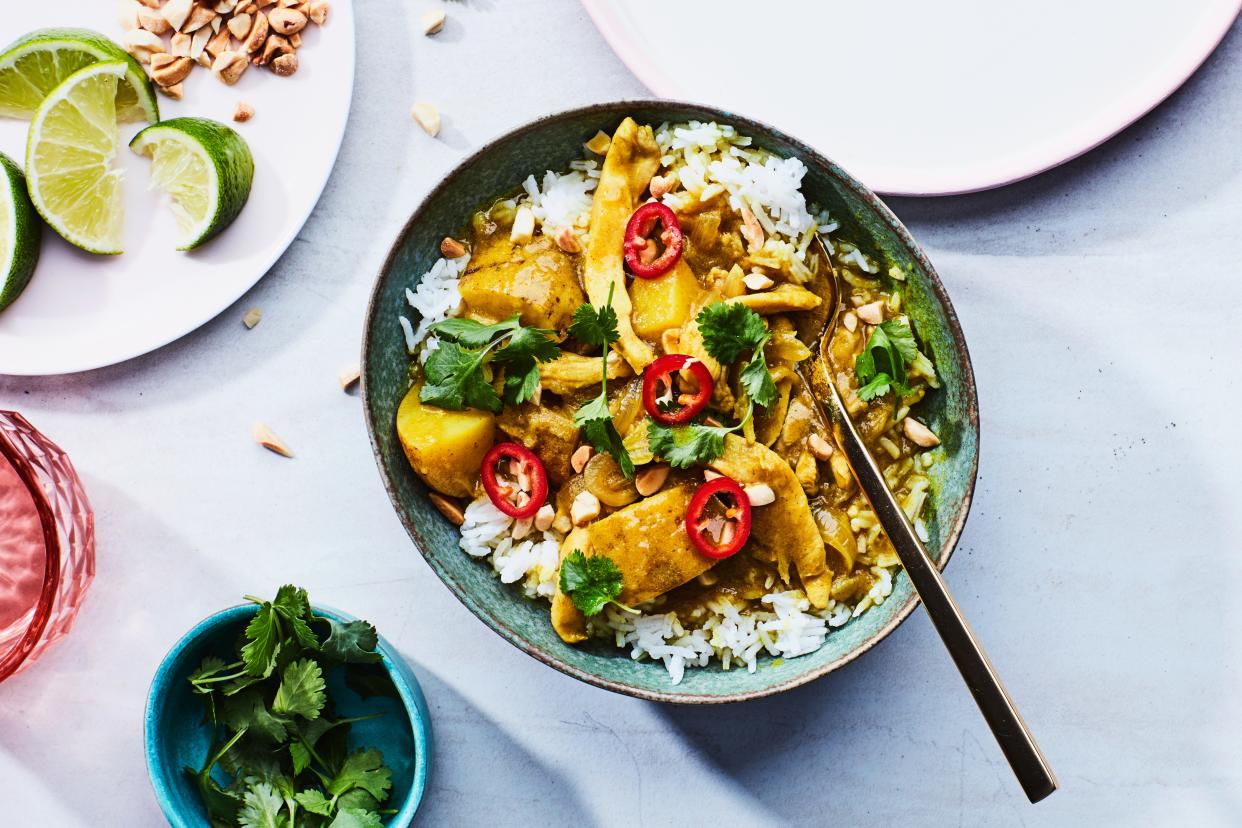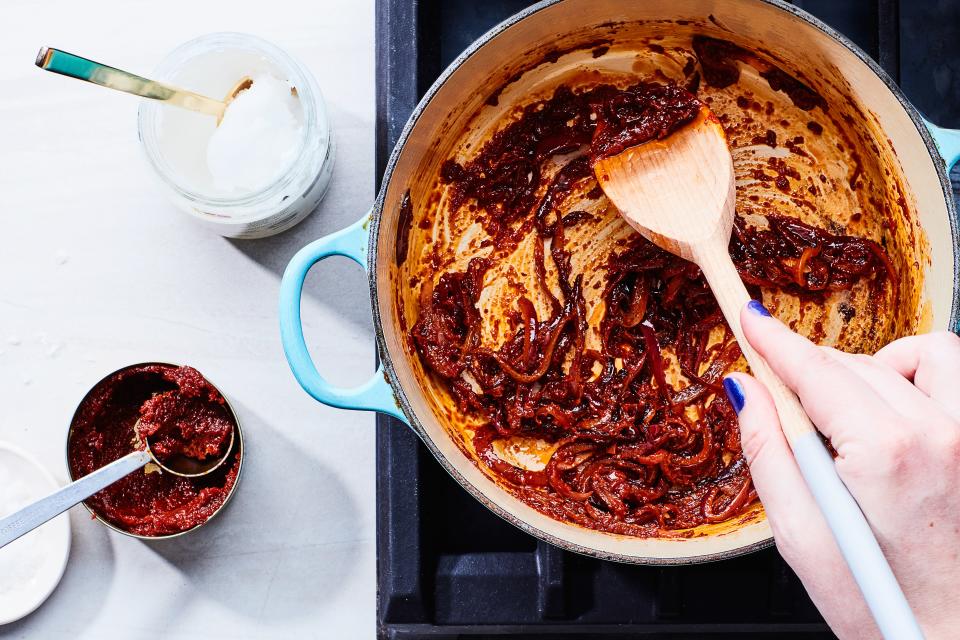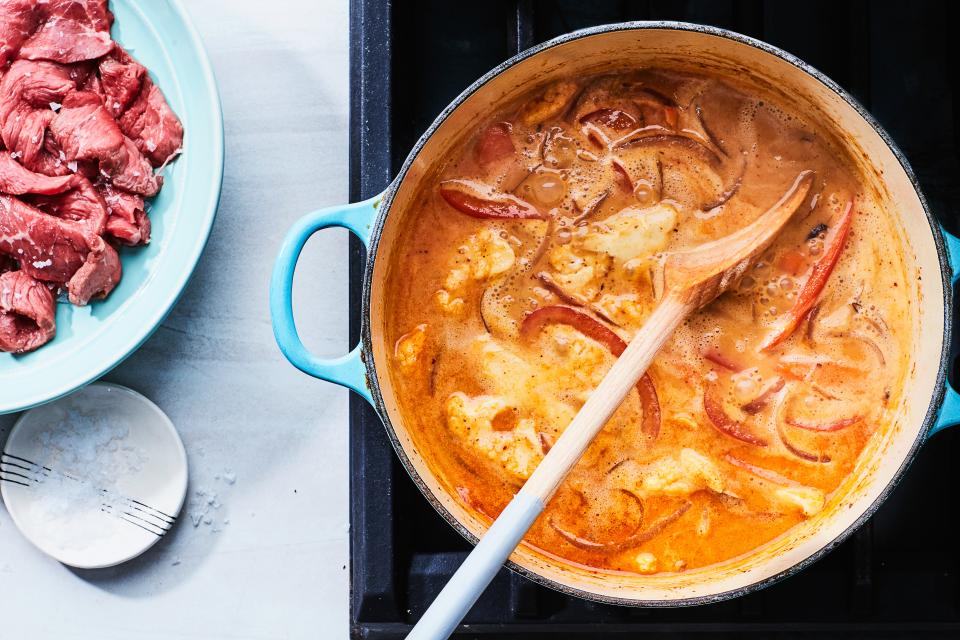How to Make Thai Curry Without a Recipe

A creamy, warming Thai curry spooned over a bowl of fluffy white rice is exactly what I want for dinner on chilly midwinter nights. When the craving hits, here in NYC it’s easy enough to punch in the order on my phone and wait half an hour for the doorbell to ring. But in about as much time I can just make it myself, which yields a dinner I’m usually happier to eat. The trick? I always keep a can of coconut milk and a can of curry paste in my pantry. Do the same and you'll also be able to make Thai curry on a whim, with whatever vegetables and protein you have on hand—and without a recipe.

NRR Thai Curry 3
A note: my no-recipe-required technique definitely isn't the most authentic way to make a true Thai curry. But it’s a weeknight-friendly, easily adaptable version you can turn to when you need to put together a delicious, comforting meal. Here’s how to do it:
1. Start with some alliums
Thinly slice some alliums: red onions, white onions, shallots, or garlic. I like to keep them in slices rather than diced or chopped so the onion remains a more noticeable part of the curry. Throw a little coconut oil or a neutral vegetable oil (avocado, canola, grapeseed) in a pot and heat it up with your onions or garlic. Once it’s starting to sizzle, you're ready to start building your curry—you don't need to give the alliums long here, just heat them up a bit and coat them in oil.

NRR Thai Curry inset1
2. Caramelize Some Curry Paste
The real secret to richly flavored curry is in the curry paste. You could make your own—fresh curry paste is delicious, and if you make it on the weekend you can keep it in the fridge for quick weeknight curries. But if you don't have your own and you want to get a curry on the table as fast as possible, store-bought Thai curry paste is the way to go.
The flavor differences between different curry paste colors and brands can be huge, so taste the paste before you start cooking with it to know what you're working with. For a fresher, more herbaceous (and usually less spicy) curry, choose a Thai green curry paste. For a warmer, turmeric-centric curry that's closer to Indian-style curry, choose a Thai yellow curry paste. For a bolder, spicier flavor, choose a Thai red curry paste. And if you can, buy a Thai curry paste that's actually from Thailand—it'll be a lot stronger in flavor. I love this canned Maesri curry paste, which is available on Amazon—you might want to get a variety pack to see which color you like best.
The amount of curry paste you use for one batch of curry depends on the strength of your paste and you or your family's spice tolerance. So taste the paste before you start! If it's really strong, start with about 2 tablespoons of paste for a batch of curry for four. If it's really mild (which I find most standard grocery store brands are), you'll want to use closer to 1/4 cup. Add the paste to your onions in the pot and stir and cook until it darkens slightly in color and is noticeably more fragrant, about 3 minutes or so.
3. Add Coconut Milk
For a curry for four, one (13.5 ounce) can of coconut milk is the perfect amount. Pour it over your curry paste, then fill the can halfway with water, swirl that water around to get all the remaining milk in the can, and pour it into the pot as well. Stir it up and let it come to a gentle simmer over medium heat, then give your coconut curry broth a taste. If at this point you think it's not strong enough, you can add more curry paste, or maybe it just needs a little more salt. If you want to give it a bit of umami funk, add a splash of fish sauce. For a bit of sweetness to balance it out, a pinch of sugar.
4. Add Some Veggies
Once your broth is hot and tastes exactly how you want it to, you can start adding your veg. You want to add about 2 cups of chopped vegetables for a curry for four.
You can use any sliced or cut vegetables you want. I like to use a mix of potatoes and onions with chicken and yellow curry paste for a very classic Massaman-style curry, or carrots, cauliflower, and red bell pepper with beef and red curry paste. For a green curry, I keep it super-fast and simple with sugar snap peas and shrimp.
Timing is key here: you'll want to add slower-cooking vegetables like potatoes, carrots, cauliflower, or winter squash first and cook them until they're beginning to soften before adding quick-cooking vegetables like bell peppers, green beans, sugar snap peas, or bok choy.
Of course you don't need to use any slower-cooking vegetables if you don't want to, and the thinner you slice them, the faster they'll cook. To check for doneness, just poke them often with a fork and don't let them get too soft. You still need to finish your curry by adding protein, which will take a little bit of time to cook, so move on to the next step when your vegetables are still a little underdone.

NRR Thai Curry inset
5. Add Some Protein
You want to add about a pound of protein to your curry for four (increase or decrease by 1/4 pound per person, making sure to also increase and decrease the amount of liquids and vegetables accordingly as well). You can use raw chicken or beef or peeled raw shrimp or cubed tofu—you decide! For chicken, I like boneless skinless breasts or boneless skinless thighs and for beef I turn to sirloin steak or steak tips. Make sure to thinly slice chicken or beef so it's somewhere between 1/4 and 1/2 inch thick (slice against the grain for optimal tenderness).
Season the protein with a little salt, and then slide it into your simmering curry. You don't have to cook the protein long: just until it's cooked through, and then your curry is done. Chicken will take 8 to 10 minutes (slice into a piece to make sure it's fully cooked in the center) and beef will take 3 to 5 minutes. Shrimp will take about 3 minutes, as will tofu, which you just need to warm through.

NRR Thai Curry 1
6. Serve with rice and garnishes
Once your protein is cooked you're ready to serve! But taste the curry first, and adjust the seasoning one more time if needed. Then spoon your curry over rice or rice noodles or just eat it as is, perhaps with a garnish or two on top, like sliced scallions, thinly sliced hot chile peppers such as jalapeños or Thai chiles, fresh herbs such as cilantro or basil, peanuts, and lime wedges. I believe in lots of garnishes, but this is your Thai curry dinner—so choose your own adventure, and enjoy.

